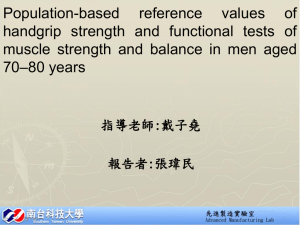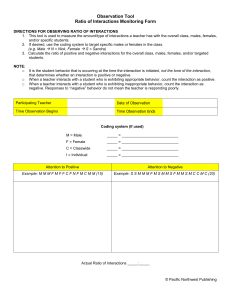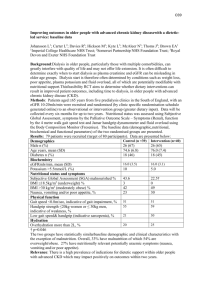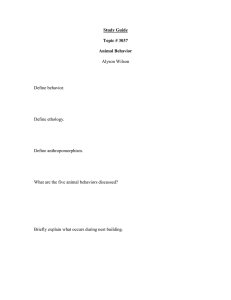Age-related Changes in Handgrip Strength among Healthy Indian
advertisement
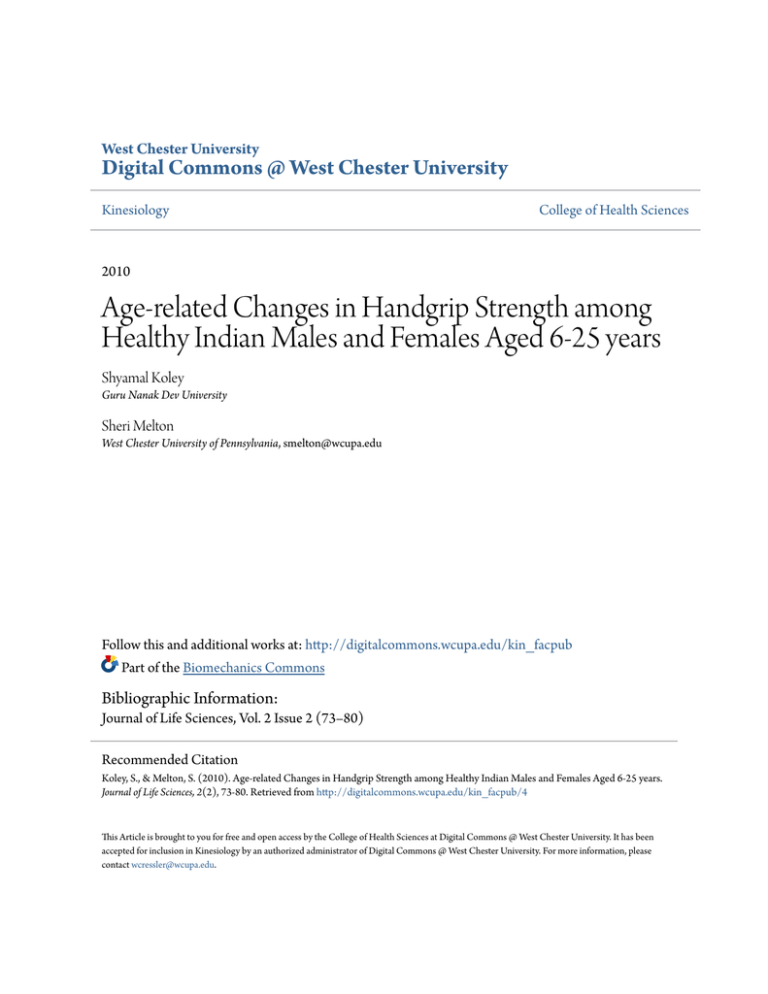
West Chester University Digital Commons @ West Chester University Kinesiology College of Health Sciences 2010 Age-related Changes in Handgrip Strength among Healthy Indian Males and Females Aged 6-25 years Shyamal Koley Guru Nanak Dev University Sheri Melton West Chester University of Pennsylvania, smelton@wcupa.edu Follow this and additional works at: http://digitalcommons.wcupa.edu/kin_facpub Part of the Biomechanics Commons Bibliographic Information: Journal of Life Sciences, Vol. 2 Issue 2 (73–80) Recommended Citation Koley, S., & Melton, S. (2010). Age-related Changes in Handgrip Strength among Healthy Indian Males and Females Aged 6-25 years. Journal of Life Sciences, 2(2), 73-80. Retrieved from http://digitalcommons.wcupa.edu/kin_facpub/4 This Article is brought to you for free and open access by the College of Health Sciences at Digital Commons @ West Chester University. It has been accepted for inclusion in Kinesiology by an authorized administrator of Digital Commons @ West Chester University. For more information, please contact wcressler@wcupa.edu. © Kamla-Raj 2010 J Life Sci, 2(2): 73-80 (2010) Age-related Changes in Handgrip Strength among Healthy Indian Males and Females Aged 6-25 years Shyamal Koley1* and Sheri Melton2 1 Department of Sports Medicine and Physiotherapy, Guru Nanak Dev University, Amritsar 143 005, Punjab, India 2 West Chester University of Pennsylvania, Kinesiology Department, West Chester, PA, 19383 USA KEYWORDS Hand Grip Strength. Anthropometric Variables ABSTRACT The purpose of the present study was to investigate the trend of handgrip strength and to assess the normative values of this trait in randomly selected 747 unrelated, normal, healthy Indian males (325 right hand and 92 left hand dominant) and females (297 right hand and 33 left hand dominant) aged 6 - 25 years from different schools and Guru Nanak Dev University, Amritsar, Punjab, India. Three anthropometric measurements, viz. height, weight and BMI were carried out with standard techniques. Handgrip strength was measured using a standard adjustable digital handgrip dynamometer (Takei Scientific Instruments Co. LTD, Japan) at standing position with shoulder adducted and neutrally rotated and elbow in full extension. The findings of the present study indicated a gradual increment of both right and left handgrip strength from 6 to 23 years in males and from 6 to age 21 years in females. Statistically highly significant sex differences (p<0.001) were found in right dominant (t = 12.84) and non-dominant (t = 13.46) handgrip strength, where males had higher mean values in all the anthropometric variables than females. INTRODUCTION The power of handgrip is the result of forceful flexion of all finger joints with the maximum voluntary force that the subject is able to exert under normal biokinetic conditions (Richards et al. 1996; Bohannon 1997) which uses several muscles in the hand and the forearm (Bassey and Harries 1993). The estimation of handgrip strength is of immense importance in determining the efficacy of different treatment strategies of the hand and also in hand rehabilitation. Grip strength determines the handedness of an individual, an important field of population variation study. It is often used as an indicator of overall physical strength (Massey-Westrop et al. 2004; Foo 2007), hand and forearm muscles performances (Nwuga 1975) and as a functional index of nutritional status (Klidjian 1982; Brozek 1984; Watters et al. 1985; Vaz et al. 1996; Jeejeebhoy 1998; Manandhar 1999; Chilima and Ismail 2001; Pieterse et al. 2002), morbidity and mortality (Klidjian et al. 1980; Phillips 1986; Guo et al. 1996), physical performance (Samson et al. 2000; Onder et al. 2002), falls and fractures (Wickham et al. *Corresponding author: Dr. Shyamal Koley, M.Sc., Ph. D. Telephone: +91 0183 2451024; Fax: +910183 2258819 E-mail: drkoley@yahoo.co.uk 1989; Lord et al. 1991). It is included in various motor ability measurement test batteries recommended for children (Pate 1989; EUROFIT 1998; Oja and Jurimae 1997; 2002). The assessment of handgrip strength assumes importance in a number of situations. It may be used in the investigation and follow-up of patients with neuromuscular disease (Wiles et al. 1990). Handgrip strength is a physiological variable that is affected by a number of factors including age, gender and body size. Strong correlations between grip strength and various anthropometric traits, (weight, height, hand length etc.) were reported earlier (Malina et al. 1987; Ross and Rösblad 2002; Singh et al. 2009; Koley and Singh 2009; Koley et al. 2009; Jurimae et al. 2009; Kaur 2009). Effects of socio-economic status on handgrip strength were studied by Henneberg et al. (1998, 2001). In case of relationships of handgrip strength with stature, weight, arm and calf circumferences and various subcutaneous skinfolds, it was found that boys attained greater values for those anthropometric variables and also had greater handgrip strength values than their girl counterparts (Benefice and Malina 1996; Koley et al. 2009). It was found too, that age dependent increase of handgrip strength in boys and girls as well as inter-gender differences were strongly associated with changes of fat free mass during SHYAMAL KOLEY AND SHERI MELTON 74 their childhood (Sartorio et al. 2002). Handgrip strength is found to be a significant determinant of bone mineral content and bone area at the forearm sites and has a positive correlation with lean body mass and physical activity. Hip/waist circumferences measurement is a good marker of fat mass, bone mineral content and lean mass which are strongly correlated with maximum isometric grip force (Rashid and Ahmed 2006). The grip strength was reported to be higher in dominant hand with right-handed subjects, but no such significant differences between sides could be documented for left-handed people (Incel et al. 2002). Right and left handgrip strength was positively correlated with weight, height and body surface area (Chatterjee and Chowdhuri 1991). The information regarding the normative values of handgrip strength in Indian males and females is scanty, so the present study was planned. MATERIALAND METHODS The present study is based on randomly selected 747 normal, healthy individuals (417 males and 330 females) aged 6–25 years of D.A.V. Public School and Khalsa College Public School and Guru Nanak Dev University, Amritsar, Punjab, India. The age of the subjects were recorded from the registers of their respective institutes, the subjects were divided in such a way that age 6 refers to the individuals aged 5 years and 6 months through 6 years and 5 months and 29 days. Of those, 325 males (77.94%) and 297 females (90.00%) were right hand dominant and 92 males (22.06%) and 33 females (10.00%) were left hand dominant. The hand dominance was determined by asking the subject to throw a tennis ball. All subjects (parents in case of children) and teachers were informed about the purpose and contents of the study. A written consent was obtained from the subjects (parents of the children). The data were collected under natural environmental conditions in morning (between 8 AM. To 12 noon). The study was approved by the local ethics committee. Anthropometry Three anthropometric variables, viz. height, weight, BMI, and grip strength of both right and left hand were taken on each subject. Anthropometric variables of the subjects were measured using the techniques provided by Lohmann et al. (1988) and were measured in triplicate with the median value used as the criterion. The height was recorded during inspiration using a stadiometer (Holtain Ltd., Crymych, Dyfed, UK) to the nearest 0.1 cm, and weight was measured by digital standing scales (Model DS410, Seiko, Tokyo, Japan) to the nearest 0.1 kg. BMI was then calculated using the formula weight (kg)/height2 (m) 2. Handgrip Strength Measurement The grip strength of both right and left hands was measured using a standard adjustable digital handgrip dynamometer (Takei Scientific Instruments Co., Ltd., Japan) at standing position with shoulder adducted and neutrally rotated and elbow in full extension. The dynamometer was held freely without support, not touching the subject’s trunk. The position of the hand remained constant without the downward direction. The subjects were asked to put maximum force on the dynamometer thrice from both sides of the hands. The maximum value was recorded in kilograms. Anthropometric equipment and handgrip dynamometer were calibrated before each assessment. All subjects were tested thrice and the best of three attempts was recorded. Thirty seconds time interval was maintained between each handgrip strength testing. Statistical Analysis Descriptive statistics (mean ± standard deviation) were determined for directly measured and derived variables. Intra and inter-group comparisons between Indian males and females for the measured variables were made using an independent t-test. Data were analyzed using SPSS (Statistical Package for Social Science) version 17.0. A 5% level of probability was used to indicate statistical significance. Correlations were estimated as per Pearson’s correlation coefficient test. RESULTS Descriptive statistics of height, weight, BMI and handgrip strength of Indian males are given in table 1. Statistically significant differences were found in height (t = 3.06), weight (t = 3.72), BMI (t AGE-RELATED CHANGES IN HANDGRIP STRENGTH AMONG HEALTHY INDIAN MALES = 2.10) and in left handgrip strength (t = 4.92) between right and left hand dominant males. Surprisingly, left hand dominant males have higher mean values for all the variables than right hand dominant males. The reason may be due to small sample size in this group. Table 2 shows the descriptive statistics of three anthropometric variables and grip strength of both hands in Indian females. The left hand dominant females have higher mean values for all the variables (except right handgrip strength) than their right hand dominant female counterparts, but the differences were statistically significant only in left handgrip strength (t = 3.21), the reason may be again the small sample size. In fact, the frequencies of left hand dominant males were only 22.06% in Indian males and 10.00% in females. That’s why sex differences for handgrip strength were done only between right hand dominant males and females (Tables are not shown) where males have higher mean values for all the five measured variables, focussing highly significant differences in height (t = 6.64), weight (t = 5.98), BMI (t = 2.49), right handgrip strength (t = 12.84) and left handgrip strength (t = 13.46). Age-wise distribution of means and standard deviations of right and left handgrip strength in right hand dominant Indian males and females are shown graphically in Figs. 1-4. In case of right 75 Table 3: Correlation coefficient of dominant right handgrip strength with anthropometric variables in Indian males and females Variables Males r Age (years) Height (cm) Weight (kg) BMI kg/m2 Left handgrip strength (kg) 0.857 0.872 0.853 0.736 0.986 Females r 0.792 0.786 0.773 0.649 0.963 All values are significant at 0.001 levels. hand dominant males, a gradual increment of right (Fig. 1) and left (Fig. 3) handgrip strength was found up to age 23 years (minimum 8.59 kg in age 6 years and maximum 43.51 kg in age 23 years in right handgrip strength and minimum 7.05 kg in age 6 years and maximum 40.16 kg in age 23 years in left handgrip strength respectively). In case of right hand dominant females, a gradual increment was noted up to age 21 years for right (Fig. 2) handgrip strength (minimum of 9.32 kg in age 6 years and maximum 24.91 kg in age 21 years) and up to age 19 years for left (Fig. 4) hand grip strength (minimum 8.50 kg in age 7 years and maximum 22.21 kg in age 19 years. The correlation coefficients (r) of dominant right handgrip strength with anthropometric variables in Indian males and females are shown Table 1: Descriptive statistics of anthropometric variables and handgrip strength in Indian males Variables Right hand dominant males (n=325) Mean Height (cm) 157.85 Weight (kg) 50.93 BMI kg/m2 19.41 Right handgrip strength (kg) 29.70 Left handgrip strength (kg) 27.21 S.D. Variance 20.38 20.95 4.78 12.89 12.05 415.34 438.90 22.85 166.15 145.20 Left hand dominant males (n=92) Mean 165.16 60.01 20.62 31.22 34.24 SD Variance 19.49 19.40 5.22 11.64 12.24 379.86 376.36 27.25 135.49 149.82 t-value 3.06* 3.72** 2.10* 1.02 4.92** *Significant at 0.05 level; * *Significant at 0.001 level Table 2: Descriptive statistics of anthropometric variables and handgrip strength in Indian females Variables Right hand dominant females (n=297) Left hand dominant females (n=33) Mean Mean Height (cm) 148.35 Weight (kg) 42.19 2 BMI kg/m 18.51 Right handgrip strength (kg) 19.13 Left handgrip strength (kg) 16.95 *Significant at 0.001 level S.D. Variance 14.52 14.68 4.17 6.17 5.44 210.83 215.50 17.39 38.07 29.59 148.84 46.11 19.78 18.65 20.29 SD Variance 17.76 17.36 4.80 6.98 7.49 315.42 315.42 23.04 48.72 56.10 t-value 0.18 1.43 1.63 0.42 3.21* SHYAMAL KOLEY AND SHERI MELTON 76 Right hand dominant grip strength (kg) 70 60 50 40 30 20 10 0 0 5 10 15 20 25 30 Age (yrs) Fig. 1. Graphic presentation of right handgrip strength of right hand dominant Indian males aged 6 – 25 years, Mean ± SD 70 Right hand grip strength (kg) 60 50 40 30 20 10 0 0 5 10 15 20 25 30 Age (yrs) Fig. 2. Graphic presentation of right handgrip strength of right hand dominant Indian females aged 6 – 25 years, Mean ± SD AGE-RELATED CHANGES IN HANDGRIP STRENGTH AMONG HEALTHY INDIAN MALES 77 70 Left hand grip strength (kg) 60 50 40 30 20 10 0 0 5 10 15 20 25 30 Age (yrs) Fig. 3. Graphic presentation of left handgrip strength of right hand dominant Indian males aged 6 – 25 years, Mean ± SD 70 Left hand grip strength (kg) 60 50 40 30 20 10 0 0 5 10 15 20 25 30 Age (yrs) Fig. 4. Graphic presentation of left handgrip strength of right hand dominant Indian females aged 6 – 25 years, Mean ± SD SHYAMAL KOLEY AND SHERI MELTON 78 in table 3. Highly significant positive correlations (p < 0.001) were observed between the grip strength of right hand dominant males and females in all the anthropometric variables, showing statistically significant positive correlations in all the sets. DISCUSSION It is reported that contractile properties of human skeletal muscles become mature early in infancy (Malina and Bouchard 1991). Handgrip strength is one of the characteristics of handedness depending which population variation is studied. Handedness is a multifactorial trait, having heredity as one of its factors. Variations in Indian populations regarding the distribution of handedness have been reported from anthropological point of view (Malhotra 1971, 1976; Dronamraju 1975; Das et al. 1985a, b, 1986a, b, c; Bhasin 1986). One important factor is noticed in this study is the high frequency of left handedness among the males of this Punjabi population. In fact, the highest frequency (19.74%) of left handedness was reported in the males of Koya Doras population of Andhra Pradesh (Dronamraju 1975) so far. But in the present study, the frequency of left handedness was reported to be as high as 22.06%, which is a striking one and a noble part of the study. The reason may be, in most of parts of India, the gene pool is comparatively rigid with restricted marriage pattern, i.e. strict endogamy, but in Punjab, gene admixture occurred since a long back, giving the population a heterogeneous status. Foreign invaders like the Persians, the Greeks, the Scythians, the Parthians, the Huns, the Turks, and the Mughals came to India through this north-west gateway, giving more chances of mixing of genetic materials. Another reason may be the small sample size. The findings of the present study indicated a gradual increment of both right and left handgrip strength from 6 to 23 years in males (Figs. 1 and 3) and from 6 to age 21 years in females (Figs. 2 and 4). In fact, apart from heredity, a number of factors are responsible for the generation of handgrip strength, viz. nutritional status (Klidjian 1982; Brozek 1984; Watters et al. 1985; Vaz et al. 1996; Jeejeebhoy 1998; Manandhar 1999; Chilima and Ismail 2001; Pieterse et al. 2002), socioeconomic status (Henneberg et al. 2001, 1998) etc. It was reported earlier that physical performance had a strong association with body strength, shape, size, form and structure of an individual (Malina et al. 1987; Ross and Rösblad 2002). The findings of the present study follows the same direction (Table 3) highlighting a highly significant positive correlation between all the anthropometric variables measured and right and left handgrip strength both in males and females. It is reported that as a rule, handgrip strength (both right and left hand dominant) is stronger in males than females across all age groups (Newman et al. 1984; Mathiowetz et al. 1986). The findings of the present study too followed the same direction in Indian males and females, reporting statistically highly significant sex differences (p < 0.001) in right dominant (t = 12.84) and non-dominant (t = 13.46) handgrip strength. Males have higher mean values in all the anthropometric variables than their female counterparts. It was, in fact, reported earlier that men possessed considerably greater strength than women for all muscle groups tested. Women scored about 50% lower than men for upper body strength and about 30% less for leg strength (McArdle et al. 2001). Sartorio et al. (2002) in their study reported that age dependent increase of handgrip strength in boys and girls were strongly associated with changes of muscle mass during their childhood. Chatterjee and Chowdhuri (1991) concluded in the same direction that right and left handgrip strength was positively correlated with age, height, weight and body surface area. It is also reported that handgrip strength determines the muscular strength of an individual (Foo 2007). So, an increase in handgrip strength determines the physical strength of an individual. The findings of the present study would be of great value in medical anthropology research, population genetics studies and in physical therapy treatment strategies. In order to properly diagnose various musculoskeletal deformities, especially related to upper extremities, and for their rehabilitation, the assessment of normative values for handgrip strength and its association with physical and physiological traits is essential. REFERENCES Bassey EJ, Harries UJ 1993. Normal values for hand grip strength in 920 men and women aged over 65 years and longitudinal changes over 4 years in 620 survivors. Clin Sci, 84: 331-337. Benefice E, Malina R 1996. Body size, body composition AGE-RELATED CHANGES IN HANDGRIP STRENGTH AMONG HEALTHY INDIAN MALES and motor performances of mild-to-moderately undernourished Senegalese children. Ann Hum Biol, 23: 307-321. Bhasin MK, Singh IP, Walter H, Bhasin V, Chahal SMS, Singh R 1986. Genetic studies of Pangwalas, Transhuman and Settled Gaddis. 4. Colour blindness, mid-digital hair, ear-lobe attachment and behavioural trait. Anthrop Anz, 44: 45-53. Bohannon RW 1997. Reference values for extremity muscle strength obtained by handheld dynamometer from adults aged 20 to 79 years. Arch Phys Med Rehab, 78: 26–32. Brozek J 1984. The assessment of motor function in adults. In: J Brozek , B Schurch (Eds.): Malnutrition and Behaviour: Assessment of Key Issues. Nestle Foundation Publication Series Vol 4, pp. 268-279 (Lausanne: Nestle Foundation). Chatterjee S, Chowdhuri BJ 1991. Comparison of grip strength and isometric endurance between the right and left hands of men and their relationship with age and other physical parameters. J Hum Ergol, 20: 41-50. Chilima DM, Ismail SJ 2001. Nutrition and hand grip strength of older adults in rural Malawi. Public Health Nutr, 9: 11-17. Das BM, Das PB, Das R, Walter H, Danker-Hopfe H 1985a. Anthropological studies in Assam, India. 1. Observations on five Mongoloid populations. Anthrop Anz, 43: 193-204. Das BM, Das PB, Das R, Walter H, Danker-Hopfe H 1985b. Anthropological studies in Assam, India. 2. Observations on Muslims. Anthrop Anz, 43: 299310. Das BM, Das PB, Das R, Walter H, Danker-Hopfe H 1986a. Anthropological studies in Assam, India. 3. Observations on three Brahmin groups. Anthrop Anz, 44: 35-43. Das BM, Das PB, Das R, Walter H, Danker-Hopfe H 1986b. Anthropological studies in Assam, India. 4. Observations on the Kalitas. Anthrop Anz, 44: 105115. Das BM, Das PB, Das R, Walter H, Danker-Hopfe H 1986c. Anthropological studies in Assam, India. 5. Observations on four further caste groups (Jogis, Hiras, Kumar, Kaibartas). Anthrop Anz, 44: 237-248. Dronamraju KR 1975. Frequency of left handedness among the Andhra Pradesh people. Acta Genet Med Gem, 24: 161-162. EUROFIT 1998. European Tests of Physical Fitness. Committee for the Development of Sport, Council of Europe, Rome. Foo LH 2007. Influence of body composition, muscle strength, diet and physical activity on total body and forearm bone mass in Chinese adolescent girls. Br J Nutr, 98: 1281-1287. Guo CB, Zhang W, Ma DQ, Zhang KH, Huang JQ 1996. Hand grip strength: An indicator of nutritional state and the mix of postoperative complications in patients with oral and maxillofacial cancers. Br J Oral Maxillofac Surg, 34: 325-327. Henneberg M, Harrison GA, Brush G 1998. The small child: Anthropometric and physical performance characteristics of short-for-age children growing in good and in poor socio-economic conditions. Euro J Clin Nutr, 52: 286-291. 79 Henneberg M, Brush G, Harrison GA 2001. Growth of specific muscle strength between 6 and 18 years in contrasting socioeconomic conditions. Am J Phy Anthrop, 115: 62-70. Incel NA, Ceceli E, Durukan PB, Erdem HR, Yorgancioglu ZR 2002. Grip strength: effect of hand dominance. Singapore Med J, 43: 234- 237. Jeejeebhoy KN 1998. Nutritional assessment. Gastroentrol. Clin North Am, 27: 347-369. Jurimae T, Hurbo J, Jurimae J 2009. Relationship of handgrip strength with anthropometric and body composition variables in prepubertal children. J Copmar Hum Biol, 60: 225-238. Kaur M 2009. Age-related changes in hand grip strength among rural and urban Haryanvi Jat females. J Copmar Hum Biol, 60: 441-450. Klidjian AM, Foster KJ, Kammerling RM, Cooper A, Karran SJ 1980. Relation of anthropometric and dynamometric variables to serious post-operative complications. Br Med J, 281: 899-901. Klidjian AM, Archer TJ, Foster KJ, Karran SJ 1982. Detection of dangerous malnutrition. J Parenter Enteral Nutr, 6: 119-121. Koley S, Singh AP 2009. An association of dominant hand grip strength with some anthropometric variables in Indian collegiate population. Anthrop Anz, 67: 21-28. Koley S, Kaur N, Sandhu JS 2009. Association of hand grip strength and some anthropometric traits in female labourers of Jalandhar, Punjab, India. J Life Sci, 1: 57-62. Lohmann TG, Roche AF, Martorell R 1988. Anthropometric Standardization Reference Manual. Champaign, IL: Human Kinetics Books. Lord SR, Clark RD, Webster IW 1991. Physiological factors associated with falls in an elderly population. J Am Geriatr Soc, 39: 1194-2000. Malina RM, Bouchard C 1991. Growth, Maturation and Physical Activity. Champaign: Human Kinetics Books. Malina RM, Zavaleta AN, Little BB 1987. Body size, fatness, and leanness of Mexican American children in Brownsville, Texas: changes between 1972 and 1983. Am J Public Health, 77: 573-577. Malhotra KC 1971. Population Biology of the Three Split Gavda Groups of Goa. Proc Int Sym Hum Genet Stat Med, Andhra University, Waltair, pp. 203-232. Malhotra KC 1976. Morphological Variation among 5 endogamous Castes of Delhi Region. 1. Somatoscopic variation. Technical Report No. Anthrop, Calcutta: ISI. Manandhar MC 1999. Undernutrition and Impaired Functional Ability amongst Elderly Slum Dwellers in Mumbai, India. Ph.D. Thesis, London School of Hygiene and Tropical Medicine. Massey-Westrop N, Rankin W, Ahern M, Krishnan J, Hearn TC 2004. Measuring grip strength in normal adult: Reference ranges and a comparison of electronic and hydraulic instruments. J Hand Surg, 29A: 514-519. Mathiowetz V, Wiemer DM, Federman SM 1986. Grip and pinch strength norms for 6 to 19 years olds. Am J Occup Ther, 40: 705-711. McArdle WD, Katch FI, Katch VL 2001. Exercise 80 Physiology: Energy, Nutrition, and Human Performance. 5 th Edition. Philadelphia: Lippincott Williams and Wilkins, pp. 506-507. Newman DG, Pearn J, Barnes A, Young CM, Kehoe M, Newman J 1984. Norms for hand grip strength. Arch Dis Child, 59: 453-459. Nwuga V 1975. Grip strength and grip endurance in physical therapy students. Arch Phys Med Rehab, 56: 296-299. Oja L, Jurimae T 1997. Assessment of motor ability of 4 and 5 year old children. Am J Hum Biol, 9: 659664. Oja L, Jurimae T 2002. Changes in anthropometrical characteristics during two years in 6 years children. Anthrop Anz, 60: 299-308. Onder G, Penninx BW, Lapuerta P, Fried LP, Ostir GV, Guralnik JM, et al. 2002. Changes in physical performance over time in older women: the women’s Health and Aging Study. J Geronol Biol Sci Med Sci, 57: M289-M293. Pate RR 1989. The case for large scale physical fitness testing in American youth. Pediatr Exercise Sci, 1: 290-294. Phillips P 1986. Grip strength, mental performance and nutritional status as indicator of mortality risk among female geriatric patients. Age and Ageing, 15: 53-56. Pieterse S, Manandhar M, Ismail S 2002. The association between nutritional status and hand grip strength in older Rwandan refugees. Eur J Clin Nutr, 56: 933-939. Rashid R, Ahmed SF 2006. Assessment of bone health and body composition in Glasgow school children. European Congress of Endocrinology. Abstract (No. 11) pp. 35. SHYAMAL KOLEY AND SHERI MELTON Richards L, Olson B, Palmiter-Thomas P 1996. How forearm position affects grip strength. Am J Occup Therap, 50: 133 – 139. Ross CH, Rösblad B 2002. Norms for grip strength in children aged 4–16 years. Acta Paediatrica, 91: 617625. Samson MM, Meeuwsen IB, Crowe A, Dessens JA, Duursma SA, Verhaar HJ 2000. Relationships between physical performance measures, age, height and body weight in healthy adults. Age and Ageing, 29: 235242. Sartorio A, Lafortuna CL, Pogliaghi S, Trecate L 2002. The impact of gender, body dimension and body composition on handgrip strength in healthy children. J Endocrinol Invest, 25: 431-435. Singh AP, Koley S, Sandhu JS 2009. Association of hand grip strength with some anthropometric traits in collegiate population of Amritsar. Orient Anthrop, 9: 99-110. Vaz M, Thangam S, Prabhu A, Shetty PS 1996. Maximal voluntary contraction as a functional indicator of adult chronic undernutrition. Br J Nutr, 76: 9-15. Watters DA, Haffejee AA, Angorn IB, Duffy KJ 1985. Nutritional assessment by hand grip dynamometry. S Afr Med J, 68: 585-587. Wickham C, Cooper C, Margetts BM, Barker DJP 1989. Muscle strength, activity, housing and the risk of falling in the elderly people. Age and Ageing, 18: 751. Wiles CM, Karni Y, Nicklin J 1990. Laboratory testing of muscle function in the management of neuromuscular disease. J Neurol Neurosurg Psychiat, 53: 384-387.
